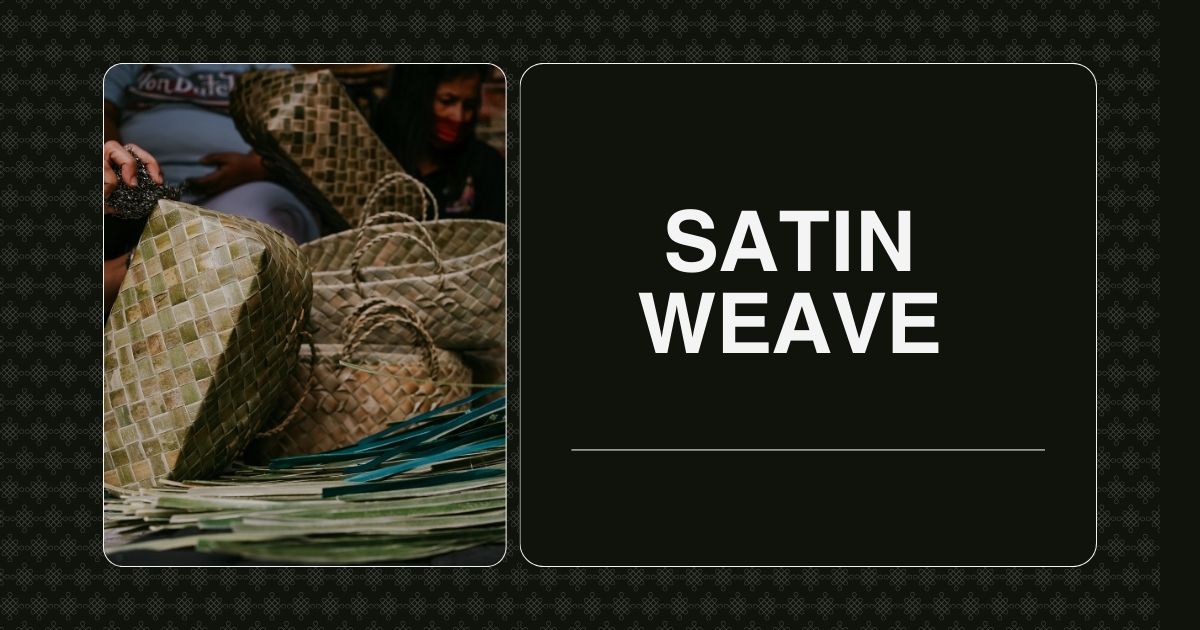Satin weave is one of the three fundamental types of textile weaves, alongside plain and twill. It stands out for its smooth, lustrous surface and luxurious appearance. Whether you’re browsing a fabric store or admiring a wedding dress, chances are you’ve encountered satin’s distinctive sheen.
How Satin Weave Is Constructed
The satin weave is created by floating warp or weft yarns over multiple yarns before interlacing. A common pattern might have a thread going over four and under one. This structure minimizes the number of intersections, creating that trademark glossy finish on one side and a dull back.
Warp-Faced vs. Weft-Faced Satin
Satin can be warp-faced or weft-faced, depending on which set of yarns predominates on the surface. Warp-faced satin has more warp threads showing on the front, giving it a shinier and stronger appearance, while weft-faced is slightly less common but still used in decorative fabrics.
Materials Commonly Used in Satin Weaves
Traditionally, satin was made using silk, but modern satin fabrics may use polyester, nylon, or acetate. Synthetic fibers offer similar shine and drape at a much lower cost, making satin accessible across a wide market.
Unique Visual and Tactile Characteristics
The satin weave results in a smooth, almost slippery texture that’s soft to the touch. The surface reflects light beautifully, giving garments and furnishings a glamorous, high-end look. This is one reason satin is a go-to choice for formal wear and interior design.
Strength and Durability of Satin Fabric
While satin looks delicate, it’s stronger than it appears—especially when made with synthetic fibers. However, its long yarn floats make it prone to snagging and less durable than tighter weaves. Proper care can extend its lifespan significantly.
Advantages of Satin Weave
One of the biggest perks of satin is its aesthetic appeal. The weave structure enhances the fabric’s softness and drape, making it ideal for flowing garments and elegant bedding. It also resists wrinkles better than some other weaves, especially when synthetic fibers are used.
Disadvantages of Satin Weave
Despite its beauty, satin can be tricky. It snags easily, requires special care, and may fray at the edges. Additionally, it can be slippery to work with in sewing projects, which might frustrate beginners.
Popular Applications in Fashion Industry
Satin is a staple in evening gowns, wedding dresses, lingerie, ties, and blouses. Its graceful drape and shiny finish make it a favorite among designers looking to evoke elegance and sensuality in their collections.
Use of Satin in Home Decor
Beyond clothing, satin is often found in home textiles like curtains, pillowcases, upholstery, and bedspreads. Its silky feel is especially sought after for luxury bedding, where it’s valued for both looks and comfort.
Cultural Significance of Satin Fabric
Throughout history, satin has been a symbol of wealth and prestige. In ancient China and the Middle East, satin garments were reserved for royalty and aristocrats. Even today, the fabric carries a sense of sophistication and exclusivity.
Satin Weave in Wedding and Event Decor
Weddings and high-profile events often incorporate satin in tablecloths, chair sashes, and dresses. Its soft shine complements the elegance and romantic atmosphere of such occasions, enhancing the visual impact.
How to Properly Care for Satin Fabric
Caring for satin depends on the fiber content. Silk satin usually requires dry cleaning, while synthetic satin may be hand- or machine-washed on a gentle cycle. It should be ironed inside out using a low heat setting to avoid damaging the sheen.
Differences Between Satin and Sateen
Although they look similar, satin and sateen differ in weave direction and fiber. Satin is typically made with filament fibers like silk or polyester, while sateen uses short-staple fibers like cotton and employs a weft-faced weave, giving it a more matte finish.
Tips for Sewing with Satin
Sewing satin demands patience and precision. Use sharp needles, pins sparingly, and consider a walking foot to avoid slipping. Cutting with tissue paper underneath and using fine thread helps maintain clean lines and prevents puckering.
How to Identify Genuine Satin Fabric
Genuine satin has a distinct luster, smooth feel, and flexibility. Check both sides of the fabric—the shiny side should contrast with the dull side. Stretch it slightly; real satin tends to have less give than imitations and feels cool to the touch.
Eco-Friendly Alternatives to Traditional Satin
As sustainability becomes more important, eco-conscious alternatives like organic cotton sateen and recycled polyester satin have emerged. These options offer similar aesthetic qualities without the environmental impact of virgin fibers.
Why Satin Remains a Timeless Fabric
Despite changing fashion trends, satin endures because of its unparalleled blend of elegance and functionality. Its presence in both high fashion and everyday items shows that this centuries-old weave still has a firm place in modern textiles.
Conclusion
Satin weave is more than just a pretty fabric—it’s a product of intricate craftsmanship and centuries of textile evolution. With its stunning sheen, luxurious feel, and versatility, it continues to captivate designers, decorators, and fashion lovers alike. While it has its quirks and care requirements, the results are often worth it. Whether you’re dressing up for a formal event or simply upgrading your bedroom decor, satin remains a timeless choice.
FAQs
What makes satin weave different from other weaves?
Satin weave minimizes interlacings between threads, creating a smooth, shiny surface unlike plain or twill weaves which show a more textured appearance.
Is satin the same as silk?
No, satin is a weave, and silk is a fiber. You can have silk satin, but satin can also be made from polyester, nylon, or acetate.
Can I machine wash satin fabric?
Synthetic satin is often machine washable on gentle settings, but silk satin should usually be dry-cleaned to maintain its quality.
Is satin a good fabric for summer wear?
Yes and no. Satin feels cool to the touch, making it refreshing in warm climates, but it may not be the most breathable depending on the fiber.
What are some affordable alternatives to silk satin?
Polyester and nylon satin provide similar looks at a fraction of the cost, making them great choices for budget-friendly projects.











